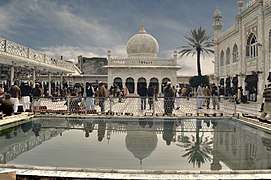Shrine of Meher Ali Shah
| Shrine of Peer Meher Ali Shah پير مہر علی شاہ مزار | |
|---|---|
 The shrine of Peer Meher Ali Shah is located in Golra Sharif | |
| Basic information | |
| Location | Golra Sharif, Islamabad Capital Territory |
| Geographic coordinates | 33°41′28.95″N 72°58′27.65″E / 33.6913750°N 72.9743472°ECoordinates: 33°41′28.95″N 72°58′27.65″E / 33.6913750°N 72.9743472°E |
| Affiliation | Islam (Hanafi) |
| Sector | E-11 |
| Territory | Islamabad Capital Territory |
| State | Pakistan |
| Architectural description | |
| Architect(s) | Babu Lal-Muhammad Chughtai |
| Architectural style | Islamic architecture |
The Shrine of Meher Ali Shah is a 20th century Sufi shrine that serves as the tomb of the Peer Meher Ali Shah, an early 20th century Sufi scholar of the Chisti order,[1] who was also a leader of the anti-Ahmadiya movement. The shrine is located within the Islamabad Capital Territory, in the village of Golra Sharif. Now-a-days Golra Sharif is widely known for one of its custodians (Sajjada Nasheen) Pir Syed Naseer Uddin Naseer Gilani.At present this spiritual place's custodian (Sajjada Nasheen) is Peer Syed Shah Abdul Haq Gilani the younger son of Babuji.
Location
The mausoleum is situated in the village of Golra Sharif, near the Margalla Hills, in the Islamabad Capital Territory, Pakistan. The shrine is situated an altitude of about 520 m (1,710 ft) above sea level.
Construction
Peer Mehr Ali Shah died on 11 May 1937[2] and was succeeded by Babuji. The construction of the mausoleum took nearly twenty years to be fully completed. For this purpose, Marble was brought from the Makrana mines in Jodhpur State.[3]

See also
References
- ↑ Mehr Muneer Biography of Meher Ali Shah
- ↑ "Pir Mehr Ali Shah". spiritualfoundation.net. Archived from the original on July 2, 2014. Retrieved July 2, 2014.
- ↑ "Construction of the mausoleum". thelightofgolrasharif.com. Archived from the original on July 2, 2014. Retrieved July 2, 2014.
4. Meher e Muneer, biography of Peer Mehar Ali Shah in English by Dr Muhammad Fadil Khan
External links
| Wikimedia Commons has media related to Mausoleum of Meher Ali Shah. |